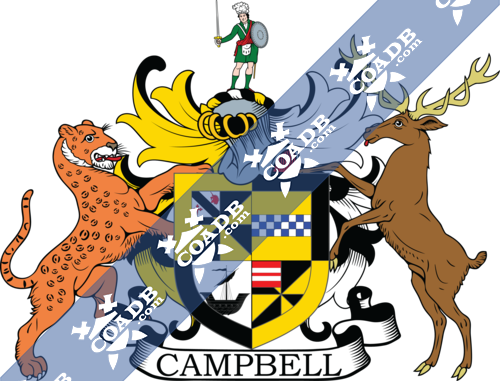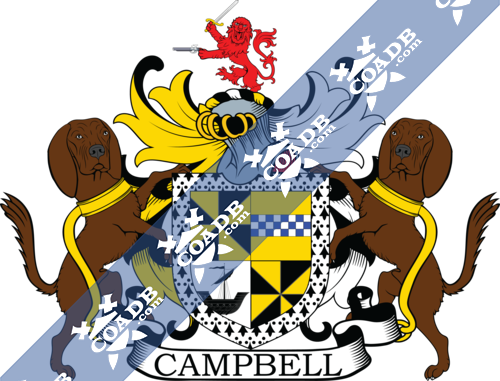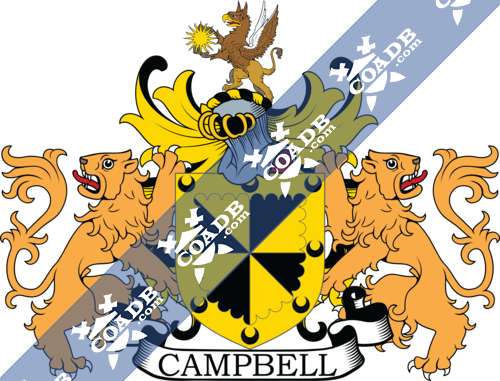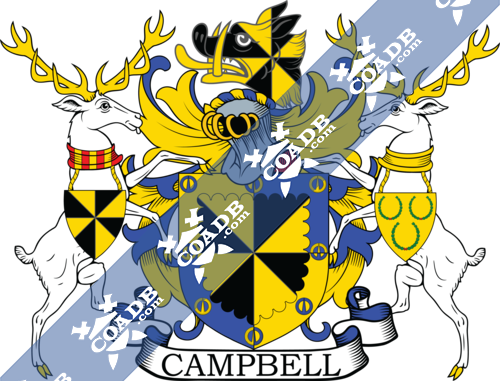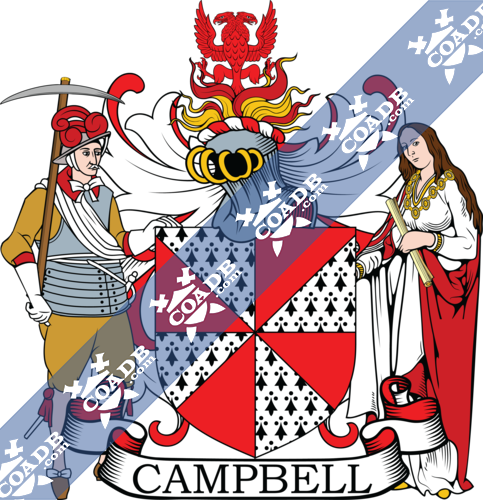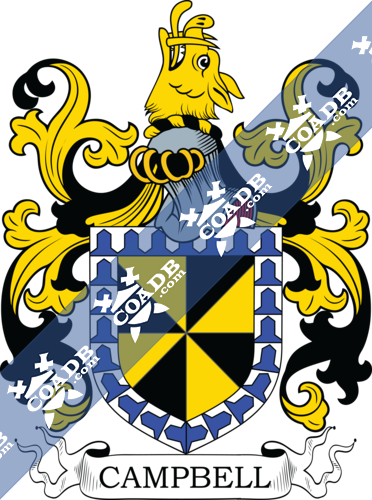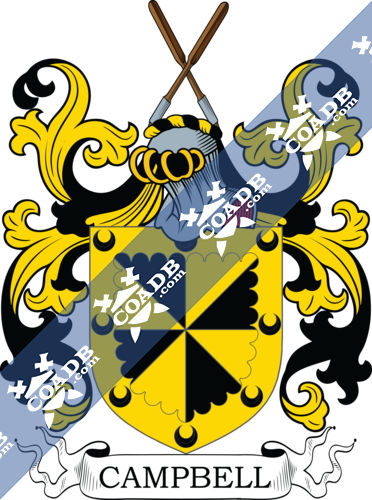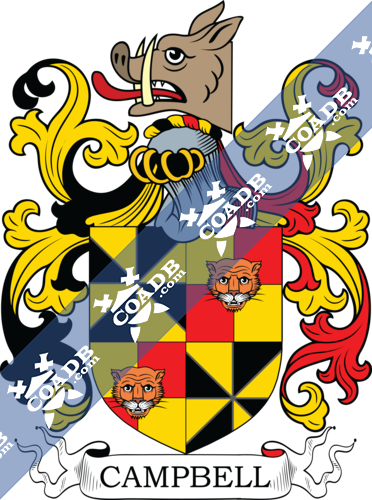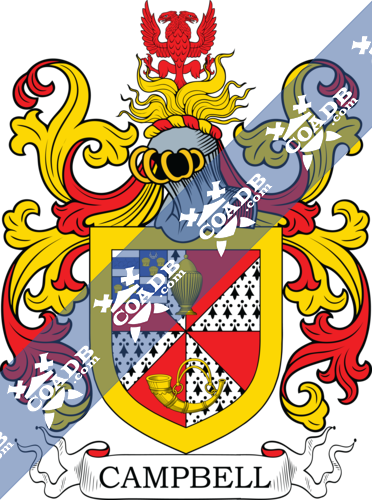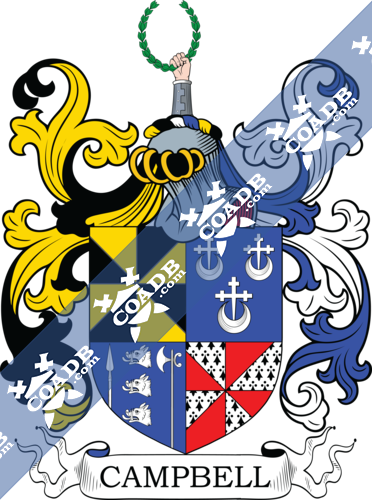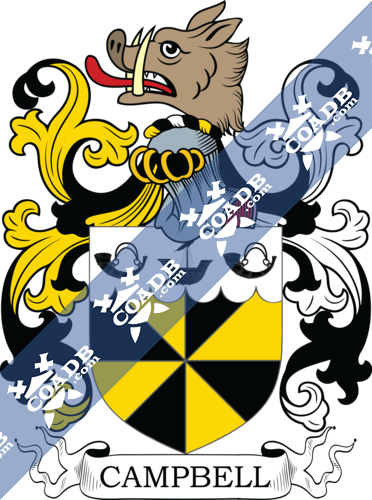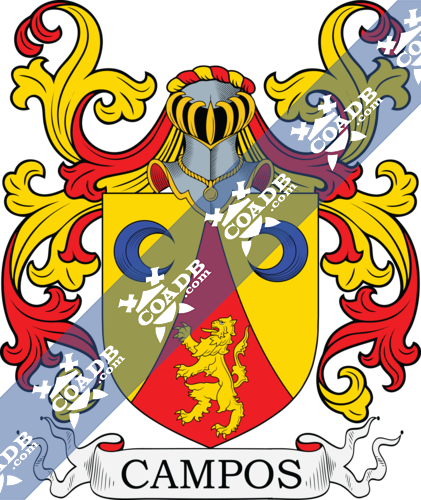Campbell Family Crest, Coat of Arms and Name History

Campbell Coat of Arms Gallery
Don’t know which Coat of Arms is yours?
We can do a genealogical research. Find out the exact history of your family!
Learn MoreSurname Name Meaning, Origin, and Etymology
This is a mostly Scottish last name that derived from a nickname from the Gaelic words cam (crooked or bent and beul (mouth), and hence literally translates to the person with the crooked mouth. It is not uncommon for surnames to derive from the physical attribute of peculiarities of the original bearers. However, it is also possible that it does not refer to a physical trait, but instead refers to someone who told lies or made false promises, perhaps a jibe at a political of societal rival.
In Latin documents, it gets the name is spelled de bello camp, meaning “of the fair field”, which sometimes caused the name to be translated to the Anglo-Norman name Beauchamp. It should also be noted that in old New English documents, the name sometimes occurs as a representative of the French name Hamel.
Another source, An Etymological Dictionary of Family and Christian Name, authored by William Arthur in 1857, states this is a Celtic and Gaelix name, come from wry-mouth, a sobriquet for a person whose mouth in inclined at one side. The name can be traced back as early as the beginning of the 400s AD, and was possessed of Lochore, in Argyleshire, Scotland, during the time of Fergus II (King of Dal Riata who died in 501 AD). A one Sir Colin Campbell of Lochore flourished in the end of the 1200s AD and was also called Sir Colin More or Colin the Great, whose descendants were called McCallen in Ireland.
Another source, Mark Anthony Lower, in his book, Patronymica Britanica, says that the claim the surname is Norman in origin is unfounded. He states “It is based upon the presumed existence of
a Norman family called De Campo Bello. Skene says that no such name is found, though the Beauchamps did most certainly so latinize themselves”. The earliest spelling of the name is Cambel or Kambel that was documented in the Ragman Roll of 1296 AD. There were two prominent branches of this family: MacArthur and MacCailinmor. He believes it has a Gaelic origin, as did Willam Arthur. The family was most dense and powerful in the Scottish Highlands, under the royalty and dukes of Argyle, and they were able to muster up to 5,000 militia men to fight the Stuart family. They became dreaded by others clans, leading to the disparaging proverb “Like a Campbell, ever fair and false”.
One source belives the Campbells were originally known as “Clana Duibhne” or “O’Duine”, deriving from one Diarmid O’Duine of Lochow. Campbell is the surname of the Dukes of Argyll, dating from 1445 AD, and their coat of arms is blazoned as follows: Quarterly, first and fourth, gyronny of eight gold and black, the Crest being a boar’s head couped gold. Another source claims the name was first used by a Strathclyde-Briton family that lived on the English/Scottish borders. The Clan Campbell was known as Siol Diarmaid an Tuirc or, alternatively, the Clan Duibhne, and was ancestor of the Lords of Lochow in 1368 AD.
Another theory is that the name is of Irish origin. MacLysaght, the former Chief Herald of Ireland, argued the MacCathmhaoil (usually anglicised as Campbell) derived their name from the Irish words for ‘battle-chief.’ The MacCathmhaoil were one of the dynasties descended from the Clann O’Neill.
Spelling Variations
Common spelling variants include Cambel, Cambell, Camble, Cammell, and several others. One source associates the name with the surname Gamble, which is Gamli in Norse, Gamel in Dutch, and Kammell in Germany. The Domesday Book of 1086 AD mentions people bearing the following personal (first) names: Game, Gamel, and Gam.
Popularity & Geographic Distribution
The last name ranks 43rd in the United States as of the 2000 Census. McCampbell ranked 17,422. The name is popular throughout the country, but is densest in Vermont, Maine, Tennesse, Virginia, Indiana, and Pennsylvania. The name ranks 7th in Scotland, 3rd in Northern Ireland, 19th in Australia, and 28th in New Zealand, 4th in Jamaica, 12th in Canada, 65th in England, and 254th in South Africa.
The 1890 book, Homes of Family Names, by H.B. Guppy contains the following passage in regards to this surname “Most numerous in Argyllshire, and afterwards in Perthshire, but also fairly dispersed in other parts of Scotland” and “One of the most numerous and powerful of the Highland clans, and under the leadership of the noble house of Argyl”. Mark Antony Lower states its prominent in the province of Ulster.
Early Bearers of the Surname
One of the earliest known bearers was Gillespic Cambel who was documented in the Exchequer Rolls of Scotland in 1263 AD. A one Duncan Campbell was documented in 1390 AD and he was believed to be the first bearer who introduced the letter “p” into the surname.A charter in 1447 AD lists one Duncan le Cambeli, the first Lord Campbell.
History, Genealogy, and Ancestry
The name is discussed in the 1895 book “Genealogical History of Irish Families” by John Rooney. The author claims the family descends from the (mythical?) Milesius, King of Spain, through the line of son Heremon. The family was founded by Eogan, from whom the Nothern Hy Nials and son of Nial of the Nine Hopstages, King of Ireland, in 379 AD. It was anciently spelled Cathmhaoil and meant “hero in batte”. The clan possessed lands in the modern day county of Tyrone. Another branch of this family descended from Faha Canan in 194 AD. Who was of the line of Lugadth, son of Ith, uncle of Milesius, King of Spain. The possessions of this clan wrere located in Scotland. In 1185 AD, Gilchreest MacCathmhaoil, head chieftain of Kinel Farry, who was slain by O’Hegny aided by Muintir Keevan. Gilchreest MacCathmhaoil was head chieftain of Clan Aongus, Clan Dubhinreacht, Clan Fogarty, Hy Kennoda, and Clan Colla of Fermanagh, and was chief of the councils of the North of Ireland. The name was eventually Anglicized to Campbell, Cawell, Cowell, and other names. The family was prominent in Tyrone, Monaghan, Louth, and Armagh, and they also possessed the territorial of Kinel Farry. The family also supplied many bishops in the See of Clogher. The family becAme prominent in the United States and other English colonies. Felix Cambell was a Member of Congress from New York City and the President of Long Island Trust Company, and his brother, Patrick Cambell was the Chief of Police in Brooklyn, New York. Timothy J. Cambell was a member of Congress from New York City. The author lastly states, the McAllens of Allens of Innishowe, Donegal are really Campbells.
From 1250 AD on, a branch of this Scottish clan, the MacAilin, lived on Dongel. From the middle of the sixteenth century, there was a second wave of mercenary soldiers from Scotland, the red-shanks, included many Campbells from Argyll. The were called red-shanks because they wore bare legged kilts, mainly in Ulster and Connact during the summer months.
The greatest settlement of Scottish Campbells to Ireland was in the Plantation of Ulster. In 1607, the sudden and significant flight of the earls (O’Neill, O’Donnell, Maguire and their allies), paved the way for the Ulster Plantation. For the remainder of the 1600s,there was continuous Scottish settlement in the east Ulster counties of Antrim and Down.
The famous genealogist Bernard Burke’s book “The Landed Gentry” discusses 26 branches of this family and provides detailed lineage/pedigrees of each: 1) Campbell of Lochnell, 2) Campbell of Barbreck, 3) Campbell of Stonefield, 4) Campbell of Jura, 5) Campbell of Inverneil and Ross, 6) Campbell of Schawfield and Islay, 7) Campbell of Blythswod, 8) Campbell of Dunnon, 9) Campbell of Monzie, 10) Campbell of Ballochyle, 11) Campbell of Treesbank, 12) Campbell of Skerrington, 13) Campbell-Renton of Lamberton, 14) Campbell of Edenwood, 15) Campbell of Colgrain, 16) Campbell of South Hall, Campbell of Stracathro, 17) Campbell of Tullichewan, 18) Campbell of Woodseat, 19) Campbell of Buscot Park, 20) Campbell of Arkinglas, 21) Campbell of Ardchatt Priory, 22) Campbell of Glenlyon, 23) Campbell of Auchmannoch, 24) Campbell of Fairfield, 25) Campbell of Ballimore, and 26) Campbell of Craigie.
The first discussed is Campbell of Lochnell. It begins with a mention of Duncan Campbell, Esq. of Lochnell in county Argull who was a Justice of the Peace and D.L born in 1806 who succeeded his father in 1845. Burke traces the lineage of this branch back to The Campbells of Lochnell, the latest cadets of Argyll, who descend from John, 4th Duke of Argyll.
The second discussed is Cambell of Barbreck. It begins with a mention of Colin Yorke Campbell, Esq. of Barbreck, Argyleshire, J.P. and D.L, born in 1812 who was a Vice Admiral of the Royal Navy. He married Elizabeth, daughter of James Hyde of the Isle of Wight, and had three issue with her: Donald Charles Douglas (1848), James Archibald (1848), and Susan Helena. Burke traces this branch to Cambell of Lochnell, who is the nearest cadet of the Ducal house of Argyll. The property of Barbreck was purchased by General John Campbell, who entailed it upon his nephew the late General Duncan Campbell of Lochnell.
One branch is traced all the way back to a man named Smervimore Amid Coslidh who was born in 510 AD. He had a son named Feither Our (591 AD), who had a son named Duibhn Mor (620 AD), who had a son named Arthur Oid Macduibhn (684), who had a son named Feriher Eile (730), who had a son named Duibgn Fuilt Derg MacDuibhn (700), who had a son named Ferither Finruo (837), who had a son named Dwbhn Derg (born 860 AD in Lochow, Argyleshire Scotland), who had a son named Dubhn Doun (904), who was the father of Diarmid Macduign MacDubhn who was born in 982 AD. He had a son named Duina MacDuibhn born in 990 AD in Dumbartsonshire. He married a woman of the O’Neill and had numerous children with her: Arthur (Armderg) ArmDerg, Dwibhne-Deab-ghall MacDuibhn, Betoc Na Ingen MacDuibhn, Paul (MacDuibhn) O’Dwibhne MacDuibhn and Malcolm MacDwine MacDuibhn. His son Malcolm MacDwine (Gillocallum” “Gillespic” MacDuign was born in 1020 in Lochow. He married Heiress Beauchamp and had three issue: Duncan Dionysius Campbell, Dwine Campbell O’Dwighne, anD Archibald Campbell. His son Arhcibald was born in 1041 AD in Menstrie, Clackmannanshire. He married a woman named Aoife and they left a son named Duncan MaDurine Campbell who was born in 1070 AD. He married Devrail Dorothy Cruachan MacFiachir and had a son named Cailen. Cailen was born in 1090 AD and married Eiall Alexander and Marjory Rus Swyfuins. He left behind Faus Coir, Iver Croumb, and Archibald. Archibald was Chief of Clan MacDuine Campbell and was born in 1130 AD. He was also known as Gillespic Campbell of Lochow. He married Finetta Fraser in 1158 AD and they had three children: Duncan, Donald, and Dugald. His son Dugald was born in 1161 in Loche, Argyll. He married Finoid Macgillvrail and they had two issue: Hugh and Archibald. His son Archibald was born in 1201. He was 8th Knight of Carrick Campbell or 7th Knight of Lochow. He married Margaret Somerville and later Errick Carrick. He left behind three issue: Gwine, Colin, and Beatrice (MacGorrie). His son Colin was born in 1220 in Stirlingshire and he was known as Sir Colin Mor or Cailen Mor Campbell. He married Janet Isabel St. Clair and they had one daughter and the following sons: Neil, Donald, Dougal, Duncan, and Gillespic.His son Neil, or Sir Neil MacCailen Mor Campbell was born in 1258 AD. He married Alyse Crawford, Mariota Cameron, and Mary (Bruce) Fraser. He left behind several children, including John, Colin, Sir Dougal, John (Earl of Athroll) and Duncan.
Early American and New World Settlers
The book “Genealogical Guide to the Early Settlers of America” mentions two bearers of this last name: 1) Duncan Campbell of Boston in 1685 who was a bookseller from Scotland and was a postmaster and had a wife named Susannah with whom he had issue: William (1687), Archibald (1689), Matthew (1691), Susannah (1696), and Agnes (1699) and 2) John Campbell of Boston in 1695, likely a brother of Duncan, who was postmaster and creator of the “Boston Newsletter” and had a wife named Mary with whom he had two children: Elizabeth (1696) and Mary (1704). The former bore the following coat of arms or family crest: Gyrony of eight or and sable, with a boar’s head couped as the crest.
The family also made its way into the Carribean, as the 1874 book “The Original Lists of Persons of Quality, Emigrants, Religious Exiles, and Political Rebels” makes two references to this surname: 1) Mary Campbell, daughter of Dowgall and Mary who was baptized in September of 1678 in the parish of Christ Church in Barbados and 2) Ann, wife of Patrick Campel was buried at the parish of St. Michael’s in the Barbados.
Other early American settlers include Colin Campbell (New Jersey 1685), Daniel Campbell (New England 1716), Elizabeth Campbell (New York 1738), Ronald Campbell (New York 1738), Dugald Campbell (New York 1739), and Anna Campbell (New York 1739). Some of the earliest bearers of this surname that settled in Canada were Angus, Archibald, and Robert Campbell who landed in Nova Scotia in 1749.
Mottoes
The Campbell family has 56 mottoes as follows:
Agite pro viribus = Act according to your strength
Armis et fide = By arms and fidelity (Campbell of Auchawilling)
Army parata fero = I carry arms in readiness
Audaces juvo = I help the brave
Audaces juvat = Fortune favors the bold
Audacter et aperte = Boldly and openly
Campi fere praemia belli = Bear off the prizes of war from the field
Candidus cantabit moriens = The pure heart shall sing when dying
Constans et prudens = Steady and wise steadfastly (Campbell of Skerrington)
Constanter et prudenter = Prudently and steadfastly (Campbell of Sombey)
Deo volenete = God willing
Fac et spera = Do and hope
Festina lente = Be quick without impetuosity
(This motto is originally a Greek maxim assigned by Aulus Gellius to Augustus, to whom the former gives great credit, for having found means so briefly to express a maxim of a very peculiar nature, including, as he expresses it, both “ industria? celeritas,” and “ diligentiae tarditas,” a quickness of application with wariness of proceeding.)
Fides probata coronat = Approved faith confers a crown
Fidus amicus = Faithful friend (Campbell of Islay)
Fit via vi = Strength is the way
Fortitudine et prudentia = Fortitude and Prudence
Gaudium adfero = I bring good tidings
Honore et armis = By honor and arms
Labore et perseverantia = Through labour and perseverence
Lente sed opportune = Slowly but opportunely/suitably
Mar bu mhiann dom = unknown translation
Ne obliviscaris = Forget not
Nunquam obliviscar = I will never forget
Optime quod opportune = What is done opportunely is best
Paratus sum = I am ready
Per crucem ad lucem = Through the cross to the light
Perse verantia victor = By patience and perseverance
Pro patria semper = Always for country
Pro artis et focus = For our altars and our homes (Campbell of Shirven)
Qua panditur orbis =Where the world extends
Quae recta sequer = I will follow the things which are right
Quid non pro patria = What would not one do for his country (Campbell of Perthshire)
Refero = Answer or I bring back (Campbell of Gargunnock)
Sequitur victoria fortis = Victory follows the brave
Tandem licet sero = At length though late
Terra mare fide = By the earth, sea and faith (Campbell of Ardintenny)
Ulterius et melius = Farther and better
Vigilando = Guarding
Vincit labor = Work conquers all
Vis et fides = Power and fidelity
Vix ea nostra voco = I scarcely call these things our own (of Weasenham, Cockley, Cley, & Fakenham)
Wisdom’s beginning is God’s fear = Wisdom’s beginning is God’s fear
Without fear =Without fear
Be mindful (Campbell of Moy)
Sequor = Follow me or I follow
I bear in mind
I byde my tyme (Campbell of Auchmannock)
Set on = Set on
Thus far (Campbell of Glenfalloch)
True to the end (Campbell of Powis)
Forget me not
Forget not (Campbell of Auchinbreak)
Forward
If I can (Cambell Colquhon of Killermont)
Memini (I remember)
Set on
Tandem licet sero = At length through late
Grantees
The first arms listed is considered the oldest arms. We have 75 coats of arms for this surname depicted here. They are from Bernard Burke’s General Armory of England, Ireland, and Scotland, which was publishes in 1848. The bottom of this page contains the blazons, and in many instances contains some historical, geographical, and genealogical about where coat of arms was found and who bore it.
Notables
Famous people with this last name include: 1) John “Jack” Moren Campbell (1916-1999) who was the 21st Governor of New Mexico in the 1960s, 2) Jane Louise Campbell (1953) who was the first female mayor of Cleveland, 3) Ignatius Royston Dunnachie Cambell, aka “Roy” (1901-1957) who was a South African poet and satirist, 4) Alexander Campbell (1788-1866) who was a Scotish-Irish immigrant ordained minister that was known for leading the Restoration Movement in the United States, and 5) John Francis Cambell (1821-1885) who was a Scottish author and scholar of Celtic Studies also known as Young John of Islay.
Blazons & Genealogy Notes
1) (Lochow: oldest Arms). Gyronny of eight ar. and sa.
2) (Duke of Argyll). Quarterly, 1st and 4th, gyronny of eight or and sa., for Campbell; 2nd and 3rd, ar. a lymphad, her sails furled and oars in action, all sa. flag and pennants flying gu., for Lorn. Crest—A boar’s head couped or, over the crest this motto, Ne obliviscaris. Supporters— Two lions guard. gu. Motto—Vix ea nostro voco. Note. —Behind the arms are two honourable badges in saltire, viz., 1st, a baton gu. semee of thistles or, ensigned with imperial crowns ppr., thereon the crest of Scotland, i.e. a lion sejant guard, gu. crowned with the like imperial crown, having in the dexter paw a sword ppr. hilted and pomelled or., in the sinister a sceptre of the last. The other badge is a sword ppr. hilt and pomel or. The two badges are borne for Hereditary Great Master of the King’s Household, and Justice-General of Argyllshire.
3) (Glenorchy, Earl and Marquess of Breadalbane, Marquisate, extinct 1862). Quarterly, 1st and 4th, gyronny of eight or and sa., for Campbell; 2nd, or, a fesse chequy ar. and az., for Stewart; 3rd ar. a lymphad, her sails furled and oars in action all sa., for Lorn. Crest—A boar’s head erased ppr. Supporters—Two stags ppr. attired and unguled or. Motto—Follow me.
4) (Lochnell, the latest cadet of Argyll). Quarterly, 1st and 4th, gyronny of eight or and sa., for Campbell; 2nd, ar. a boar’s head az.; 3rd, Lorn, as above. Crest—A dexter hand holding a lance bendways ppr. Supporters— Dexter, a lion guard, ppr.; sinister, a swan ppr. Motto—Audaces juvo.
5) (Cawdor, 1672). Quarterly, 1st, ar. a hart’s head cabossed sa. attired gu., for Calder; 2nd, gyronny of eight or and sa., for Campbell; 3rd, ar. a lymphad oars in action sa., for Lorn; 4th, or, on a fess az. three buckles of the field. Crest—A swan ppr. crowned or. Supporters—A lion guard. gu., and a hart ppr. Motto—Be mindful.
6) (Earl Cawdor). Quarterly, 1st, or, a hart’s head cabossed sa. attired gu., for Calder; 2nd, gyronny of eight or and sa., for Campbell; 3rd, ar. a lymphad oars in action sa., for Lorn; 4th, per fess az. and gu. a cross or, for Lort. Crest—A swan ppr. Supporters—A lion guard. gu. and a hart ppr. Mottoes—Candidus cantabit morions; and, Be mindful.
7) (Moy, co. Elgin). Quarterly, as Cawdor, 1672, all within a bordure engr. or. Crest—A swan rising and crowned ppr. Motto—Be ever mindful.
8) (John Hooke Campbell, of Bangeston, Lyon, King of Arms, 1754-1756). Quarterly, 1st, Calder; 2nd, Campbell; 3rd, Lorn: all as in the last; 4th, quarterly, sa. and ar. a cross counterquartered betw. four escallopa all counterchanged, for Hooke. Crest—A swan gorged with a ducal coronet ppr. Supporters—Two lions gu. Motto—Be mindful.
9) (Ardchattan; a cadet of Cawdor). Quarterly, 1st and 4th, Campbell; 2nd, Calder; 3rd, Lorn, all within a bordure gu. charged with eight crescents ar. Crest—A swan with wings elevated ar., on his head an eastern crown or. Supporters—Dexter, a stag reguard. sa. attired gu. and gorged with a ducal coronet or; sinister, a lion guard, gu. gorged with a mural crown or. Motto—Be mindful.
10) (Ottar, descended of Thomas, second son of 1st Earl of Argyll). Gyronny of eight erm. and sa. Crest—A. hand in pale holding a dirk erect ppr. Motto—Pro patria semper.
11) (Smiddygreen, descended from Ottar). Gyronny of eight erm. and sa., on the last four stars ar.
12) (Mochaster, co. Perth, cadet of Glenorchy, whose descendant succeeded as 4th Earl and 1st Marquess of Breadalbane). Quarterly, as Earl of Breadalbane, within a bordure invecked sa. Crest—A boar’s head erased chequy or and sa. Motto—Sequor.
13) (Glenfalloch, co. Perth, cadet of Glenorchy, whose descendant succeeded as 6th Earl of Breadalbane). Quarterly, as Earl of Breadalbane, with a hunting horn sa. garnished gu. in the centre of the quarters. Crest—A man’s heart transpierced with a dart ppr. Motto—Thus farr.
14) (Lochdochart, co. Perth, cadet of Glenorchy). Quarterly, 1st, 2nd, and 3rd, as Earl of Breadalbane; 4th, or, a lion ramp. gu., for M’Intosh. Crest—A boar’s head erased ppr. Motto—Recta sequor.
15) (Auchlyne, cadet of Glenorchy). Quarterly, 1st, 2nd, and 4th, as Earl of Breadalbane; 3rd, per fess ar. and vert three unicorns’ heads couped sa. and ar. guttee gu. all armed or, for Goodlet.
16) (Monzie, co. Perth, cadet of Glenorchy). Quarterly, as Earl of Breadalbane, with a mullet or, in the centre of the quarters. Motto—Follow me.
17) (Finnall, co. Perth, 1700, cadet of Monzie of which it became the representative). Quarterly, as Earl of Breadalbane, en surtout the arms of the Scots African and Indian Company, viz., Az. a St. Andrew’s cross cantoned betw. a ship in full sail in chief, a Peruvian sheep in base, a camel pass, in the dexter flank both loaded, and an elephant in the sinister flank with a tower on his back all ppr. Crest—A soldier in armour from the middle upwards, brandishing a drawn sword in his right hand all ppr., and sustaining on his left arm a shield az. charged with a unicorn’s head couped ar. horned and maned or. Supporters—Dexter, a naked Indian wreathed round the middle with linen, holding in his dexter hand a bow bent, with a quiver of arrows hanging at his back ppr.; sinister, a Spaniard in his proper habit ppr. Motto—Quid non pro patria, above the crest; and, Qua panditur orbis, on a compartment in which is represented the sun rising ppr.
18) (Barcaldine, co. Argyll). Quarterly, as Earl of Breadalbane, within a bordure vair. Crest—A man in the Highland garb holding in his dexter hand a dirk ppr. Motto—Paratus sum.
19) (Barcaldine and Glenure, bart, 1831). Quarterly, 1st, gyronny of eight or and sa., on a canton ar. a bend sa. betw. a unicorn’s head in chief and a cross crosslet fitchee in base gu.; 2nd. or, a fess chequy az. and ar., for Stewart; 3rd, ar. a lymphad sails furled and oars in action sa., for Lorn; 4th, gyronny of eight or and sa., on a canton gu. two bars or, all within a bordure quarterly or and sa. Crest—A man in the Highland garb holding in his dexter hand a claymore and on his sinister arm a target all ppr. Supporters— A leopard and a stag both ppr. Motto—Paratus sum.
20) (Achalader, bart. 1815, recorded for Sir Alexander Campbell, 1st bart., now represented by his heir of line, Sir Alexander Cockburn-Campbell, Bart.). Quarterly, as Earl of Breadalbane, on a chief ar. the representation of a rock superinscribed “Gibraltar,” betw. the silver medal presented him by the Government of India for Seringapatam, pendent by a ribbon gu., and the gold medal for Talavera. Supporters—Dexter, a grenadier of the 74th Foot habited and accoutred ppr. bearing a banner ar. charged with a fesse gu. inscribed “Seringapatam,” in gold; sinister, a grenadier of the 7th Fusiliers habited and accoutred ppr., bearing a banner az. charged with a fesse gu. inscribed “Talavera,” in gold. Motto—Without fear.
21) (Glenlyon, co. Perth, represented by Francis Garden Campbell, of Troup and Glenlyon, as heir of line). Quarterly, as Earl of Breadalbane, in the centre of the quarters a man’s heart gu. crowned or. Crest—A demi l;on ppr. with a collar gyronny of eight or and sa., and holding in his dexter paw a heart crowned as in the arms. Motto—Quae recta sequer.
22) (General Sir Archibald Campbell, G.C.B., Bart., 1831, grandfather of present Sir Archibald Ava Campbell). Same Arms; on a chief ar. a mount vert inscribed “Ava” in letters of gold, thereon a Burmese stockade ppr. betw. a representation of the gold cross and clasp conferred on him for his services in the Peninsular War, on the dexter pendent from a ribbon gu. fimbriated az., and on the sinister pendent from a ribbon az. the badge of the Portuguese Order of the Tower and Sword. First Crest—On a mount vert a Burmese warrior on horseback armed and accoutred ppr. Second Crest—Issuing from aneastern crown or, a demi lion ppr. supporting with his dexter paw a man’s heart gu. crowned or. Motto—Perse verantia victor.
23) (Lawers, co. Perth, descended from a son by his fourth marriage of the first Laird of Glenorchy. The representative m. the heiress of Loudoun and was made Earl of Loudoun in 1633. Lawers went for a time to a younger branch of whom was Sir James Campbell, of Lawers, Lyon King of Arms under Cromwell). (Clathick, descended from Lawers, represented by Colquhoun, of Killermount, as heir of line). Gyronny of eight or and sa. a bordure vair. Crest—A boar’s head erected and erased or. Motto—Fac et spera.
24) (Aberuchill, co. Perth, bart., cadet of Lawers). Quarterly, as Earl of Breadalbane, all within a bordure erm. Crest—A lion guard. gu. crowned with laurel, in his dexter paw a sword ppr. hilted and pommelled or, and in his sinister a dag or Highland pistol ppr. Supporters—Two bloodhounds guard. ppr. collared and leashed or. Motto—Sequitur victoria forteis.
25) (Park, cadet of Lawers). Gyronny of eight or and sa. a bordure engr. az. charged with eight buckles of the first. Crest—A boar’s head erected and erased or, langued az. Motto—Fac et spera.
26) (Possil, co. Lanark, cadet of Park). Gyronny of eight or and sa. in chief a mullet counterchanged a bordure embattled az. charged with eight buckles of the first. Crest and Motto as Park.
27) (Colgrain, co. Dumbarton). Gyronny of eight or aud sa. in chief a mullet counterchanged a bordure embattled vert charged with eight buckles of the first. Same Crest and Motto.
28) (Auchinbreck, co. Argyll, bart., 1628). Gyronny of eight or and sa. a bordure compony erm and vert. Crest—A dexter hand holding a spur or. Motto—Forget not.
29) (Craigic,co. Ayr). Quarterly, 1st and 4th. gyronny of eight or and sa., 2nd, ar. a horse’s head and neck couped sa. bridled gu.: 3rd, ar. a fesse gu., the whole within a bordure compony vert and purp. Crest—A dexter hand and arm couped at the elbow erect ppr. holding a spur or. Motto—Forget me not.
30) (Ardkinglas, co. Argyll, early cadet of Lochow, bart., 1679, represented by Callander of Craigforth and Ardkinglas as heir of line; the heir-male understood to be Campbell of Peaton). Gyronny of eight sa. and or, a bordure of the second. Crest—A galley oars in action ppr. Motto—Set on.
31) (Lix, co. Argyll, cadet of Ardkinglas). Gyronny of eight sa. and ar. a bordure engr. quarterly or and az. charged with eight buckles counterchanged. Crest—A boar’s head couped ppr. Motto—Deo volente.
32) (Ardentinny, co. Argyll, cadet of Ardkinglas). Gyronny of eight sa. and or, a bordure of the first charged with eight crescents of the second. Crest—Two oars of a galley in saltire ppr. Motto—Terra mare fide.
33) (Auchawillig, cadet of Ardentinny). Gyronny of eight sa. and or, a bordure of the second charged with eight crescents of the first. Crest—Two oars of a galley in saltire ppr. Motto—Armis et fide.
34) (Inellan and Dunoon, co. Argyll, cadet of Auchawillig). Gyronny of eight sa. and or, a bordure engr. of the second charged with eight crescents of the first. Crest—Two oars of a galley in saltire ppr. Motto—Vis et fides.
35) (Philip Arthur Pleydell Booverie Cotpbell. of Dunoon, 1869). Quarterly, 1st and 4th, grand quarters as the last; 2nd and 3rd, grand quarters counterquartered, 1st and 4th, per fesse or and ar. an eagle displ. with two heads sa., on the breast an inescutcheon gu. charged with a tend vair, for Booverie; 2nd and 3rd, ar. a bend sa. guttee d’ean betw. two crows sa. a chief chequy or and of the third, for Pleydell. Crests—Two oars of a galley in saltire ppr., for Campbell; a demi eagle displ. with two beads sa. ducally gorged or, and charged on the breast with a cross crosslet ar., for Bouverie. Mottoes—Vis et fides, for Campbell; Patria cara carior libertas, for Bouverie.
36) (Skipness, cadet of Ardentinny). Gyronny of eight sa. and or, a bordure indented of the first charged with eight crescents of the second. Crest—Two oars of a galley in saltire ppr. Motto—Terra mare fide.
37) (Shawfield and Islay). Gyronny of eight or and sa a bordure engr. of the first charged with eight crescents of the second. Crest—A griffin erected holding the sun within his forepaws ppr. Supporters—Two lions reguard. ppr. Motto—Fidus amicus.
38) (Blythswood, co. Renfrew). Quarterly, 1st and 4th, gyronny of eight or and sa., each charged with a trefoil slipped counterchanged; 2nd and 3rd, ar. a lymphad sa. Crest—A ship at anchor ppr. Motto—Vincit labor.
39) (Carrick). Gyronny of eight sa. and or, a bordure invecked of the first charged with eight crescents of the second. Motto—Set on.
40) (Barbreck, co. Argyll, from a younger son of Sir Colin Campbell, of Lochow, King Robert Bruce’s nephew). Quarterly, 1st and 4th, gyronny of eight or and sa.; 2nd, ar. a broad sword in bend gu. hilted sa.; 3rd, ar. a castle triple towered sa.; on an escutcheon of pretence sa. a boar’a head erased or, a crescent ar. in chief. Crest—A lion’s head affrontee ppr. Motto—I bear in mind.
41) (Hallyards, co. Perth, cadet of Barbreck). Quarterly, 1st, 2nd, 3rd, and escutcheon of pretence, as the last; 4th, ar. a ship in full sail ppr. in a sea undy vert, all within a bordure ar. Crest and Motto, as Barbreck.
42) (Succoth, bart. 1808). Quarterly, 1st and 4th, gyronny of eight engr. or and sa.; 2nd and 3rd, az. a lion ramp. ar. within a bordure compony of the second and first, for Wallace. Crest—A camel’s head couped ppr. Supporters—A lion guard. and a savage wreathed head and middle with oak leaves, both ppr. Motto—Labore et perseverantia.
43) (Craignish, co. Argyll). A shield gyronny of eight or and sa. suspended from the mast of a lymphad sa. Crest—A boar’s head erased ppr. Motto—Fit via vi.
44) (lnverneil, co. Argyll, bart. 1818, title extinct on death of first bart.). As Craignish, with a bordure az. Crest—A boar’s head erased ppr. Motto—Fit via vi.
45) (Campbell-McIver) (Lergahonzie and Asknish, co. Argyll). Quarterly, 1st and 4th. grand quarters, quarterly, 1st and 4th, gyronny of eight or and sa., 2nd, ar. a dexter hand couped in fesse grasping a dagger in pale gu.; 3rd, ar. a lymphad sails furled and oars in action sa.; 2nd and 3rd, grand quarters, quarterly or and gu. a bend sa., for McIver. Crest—A boar’s head couped or. Supporters—Two leopards guard, ppr. collared az. with chains thereto affixed passing betw. their forelegs and reflexed over their backs or. Motto—Nunquam obliviscar.
46) (Duchernan, co. Argyll, and Quoycrook, co. Caithness, represented by Dr. P. C. Campbell, principal of Aberdeen University). Quarterly, 1st and 4th, grand quarters, as in the last; 2nd and 3rd, grand quarters quarterly or and gu. on a bend sa. three cross crosslets ar. Crest and Motto, as the last. Additional motto below the shield—Per crucem ad lucem.
47) (Capt. John Campbell, Madras N.I., descended of Clenary, co. Perth, a cadet of Lergahonzie, 1873). Quarterly, 1st and 4th, gyronny of eight or and sa.; 2nd and 3rd, quarterly or and gu. a bend sa., all within a bordure ar. charged with six crosses moline az. Crest—A dexter hand couped in fesse grasping a dagger gu. Motto—I forget not.
48) (Ballochyle, co. Argyll). Quarterly, 1st and 4th, gyronny of eight or and sa.; 2nd and 3rd, quarterly or and gu. a leopard’s face ppr. Crest—A boar’a head couped ppr. Motto—I will not forget.
49) (Inverawe, co. Argyll). Gyronny of eight or and sa. a bordure wavy az. charged with eight salmon naiant ar. Crest—A hart’s head ppr.
50) (Glenfeochan, co. Argyll). Gyronny of eight or and sa. in the dexter chief point a boar’s head erased of the second, and in the sinister base a salmon naiant az. Crest—A stag’s head ppr. Mottoes—Mar bu mhiann dom; and Fortitudine et prudentia.
51) (Duntroon, co. Argyll). Quarterly, 1st and 4th, gyronny of eight or and sa.; 2nd, ar. a galley oars in action sa. surmounted of a boar’s head erased or; 3rd, az. a tower ar. masoned sa. all within a bordure erm. Crest—Issuing out of the top of a tower two arms drawing an arrow in a bow all ppr. Motto—Agite pro viribus.
52) (Dunstaffnage, co. Argyll, bart., 1836). Quarterly, 1st, az. a castle triple-towered ar. masoned sa. standing on a rock ppr., doors and windows gu., on the top of the middle tower a cock, and on each of the others an eagle or; 2nd, gyronny of eight or and sa.; 3rd, or, a fesse chequy az. and ar.; 4th, gu. a boar’s head cabossed or, betw. a crescent and a spur-rowel ar. in fess. Crest—An anchor in pale az. Motto—Vigilando.
53) (Loudoun, co. Ayr, hereditary sheriffs of Ayr, Lord Campbell, of Loudoun, 1601). Gyronny of eight erm. and gu.
54) (Earl of Loudoun, 1633. The 1st earl was Sir John Campbell, of Lawers, husband of the heiress of Loudoun). Gyronny of eight erm. and gu. Crest—An eagle with two necks displ. gu. in a flame of fire ppr. Supporters—Dexter, an armed man bearing a pick on his shoulder ppr.; sinister, a lady richly attired with a signet letter in her sinister hand ppr. Motto—I byde my tyme.
55) (Cessnock, co. Ayr; cadet of Loudoun). Gyronny of eight or and sa. a bordure gu. charged with eight escallops of the first, a canton gyronny of eight erm. and gu. Crest—A phoenix’s head erased or. Motto—Constanter et prudenter.
56) (Purves Hall, co. Berwick, bart., 1665, borne by Sir Hugh Hume-Campbell, Bart.). Quarterly, 1st grand quarter, 1st and 4th, vert, a lion ramp. ar.; 2nd and 3rd, ar. three popinjays vert. 2nd grand quarter, gyronny of eight or and sa. within a bordure gu. charged with eight escallops of the first, a canton gyronny of eight of the third and erm. 3rd grand quarter, az. on a fesse betw. three mascles ar. as many cinquefoils of the first. 4th grand quarter, quarterly, 1st and 4th, three piles engr. az., 2nd and 3rd, ar. a cross engr. az. over all en surtout, an inescutcheon ar. charged with an orange, slipped and imperially crowned all ppr. Crest—A dexter arm issuing from a heart, and grasping a scimitar all ppr. Supporters— Two lions ramp. reguard. ar. Mottoes: over the Crest—True to the end; under the arms—Fides probata coronat.
57) (Glassnock, co. Ayr). Gyronny of eight or and sa. a bordure engr. gu. charged with eight escallops of the first. Crest—A phoenix’s head couped ppr. Motto—Constans et prudens.
58) (Auchmannoch, co. Ayr, 1844). Gyronny of eight erm. and gu. in middle chief a covered cup or, in base a hunting horn stringed of the last; a canton, quarterly, 1st and 4th, ar. on a fesse az. three stars of the second; 2nd and 3rd, az. three garbs or, a crescent erm. in chief. Crest—A two-headed eagle displ. gu. in a flame of fire or. Motto—I byde my tyme.
59) (Catrine, co. Ayr, 1854). The same, within a bordure or. Same Crest and Motto.
60) (Skeldon, co. Ayr). Gyronny of eight erm. and gu. a bordure chequy or and sa. Crest—The wings of an eagle conjoined ppr. Motto—Ulterius et melius.
61) (Barbieston, co. Ayr). Gyronny of eight erm. and gu. a bordure wavy vert. Crest—A hand and arm holding a dagger with the sun above in his splendour, all ppr. Motto—Honore et armis.
62) (Netherplace, co. Ayr). Gyronny of eight erm. and gu. on each gyron a bezant. Crest—A hand issuant, from a cloud holding a signet letter ppr. Motto—Optime quod opportune.
63) (Waterhaughs, co. Ayr). Gyronny of eight waved erm. and gu. Motto—Tandem licet sero.
64) (Skerrington, co. Ayr, as recorded 1750). Quarterly, 1st, gyronny of eight or and sa.; 2nd, az. three cress crosslets fitchee issuant out of as many crescents ar., for Cathcart: 3rd, az. three boars’ heads erased ar. betw. a lance issuing out of the dexter and a Lochaber axe issuing out of the sinister base both erect in pale of the second; 4th, gyronny of eight erm. and gu. Crest—A dexter hand and arm in armour holding a garland of laurel all ppr. Mottoes —Campi fere praemia belli, and Wisdom’s beginning is God’s fear.
65) (Gargunnock, co. Stirling). Gyronny of eight erm. and gu. each of the last charged with a bee volant en arriere ar. Crest—A stork ppr. Motto—Refero.
66) (Balgairsho, co. Forfar). Gyronny of eight erm. and gu. a bordure engr. of the second, charged with eight crescents ar. Crest—An eagle displ. with two heads gu. issuing out of a flame of fire ppr. Motto—Lente sed opportune.
67) (Baron Stratheden and Campbell). Gyronny of eight or and sa. within a bordure engr. quarterly or and az. charged with eight buckles counterchanged. Crest—A boar’s head erased gyronny of eight or and sa. Supporters, as Lord Stratheden—On either side a buck ar. attired and hoofed or, that on the dexter gorged with a collar compony gu. and of the second, therefrom pendent an escutcheon gyronny of eight or and sa., and that on the sinister gorged with a collar therefrom pendent an escutcheon gold, charged with three chaplets of laurel, two and one, ppr. Supporters, as Lord Campbell—On either side a lion guard, gu., that on the dexter gorged with a collar or, pendent therefrom an escocheon az. charged with a saltire ar., and that on the sinister gorged with a wreath of shamrocks ppr. pendent therefrom an escutcheon or and gu. Motto—Audacter et aperte.
68) (Baron Clyde). Or, on a fess gu. a mural crown of the field. Crest—On a mural crown a swan sa. Supporters —A soldier of the 42nd Foot and a soldier of the 93rd Foot, each habited, accoutred, and holding in the exterior hand a musket ppr. Motto—Be mindful.
69) (Carrickboy, Ireland, bart.). Quarterly, 1st and 4th, gyronny of eight sa. and or, on a canton az. a bear’s head couped ar. muzzled gu.; 2nd and 3rd, ar. a lymphad sailed furled and oars in action sa. Crest—On the points of an eastern crown a boar’s head couped or. Motto—Ne obliviscaris.
70) (Tillechewan, co. Dumbarton). Gyronny of eight or and sa. on a chief invecked ar. a lymphad sails furled, and oars in action betw. two hunting-horns stringed all of the second. Crest—A boar’s head erased ppr. Motto—Ne obliviscaris.
71) (Stracathrow co. Forfar). The same, with the chief engr. for diff. Same Crest and Motto.
72) (Culreath, 1835). Gyronny of eight or and sa. on a bordure embattled vert three elephants’ heads erased ar. Crest—A boar’s head couped or.
73) (Cammo, co. Edinburgh). Gyronny of eight or and sa. on a chief az. a lymphad sails furled, and oars in action betw. two mullets of the first. Crest—A boar’s head erased sa. Motto—Follow me
74) (Blythswood, co. Renfrew, Bart.; created 4 May, 1880. Quarterly, 1st and 4th gyronny of right or and sa. eaeh charged with a trefoil slipped counterchanged; 2nd and 3rd, ar. alymphad sa. Crest—A lymphadas in the arms. Motto—Vincis labor.
75) (McIvor-Campbell, Asknish, co. Argyll, 1884). Quarterly, 1st and 4th, counterquartercd, 1st and 4th, gyronny of eight or and sa.; 2nd, ar. a dexter hand couped in fess grasping a dagger in pale gu.; 3rd, ar. a galley, sails furled and oars in action flagged sa.; 2nd and 3rd, quarterly, or, and gu. a bend sa. Crest—A boar s head couped or. Motto—Nunquam obliviscar.









